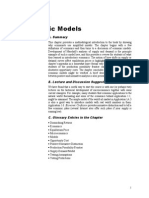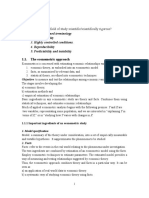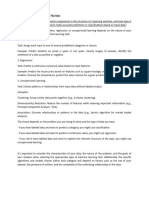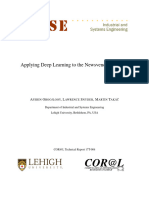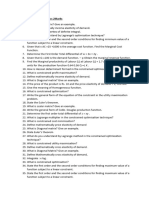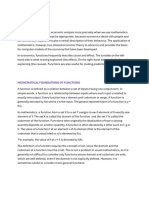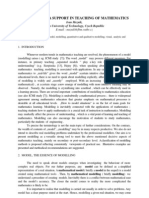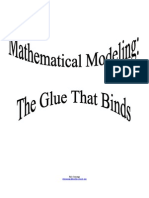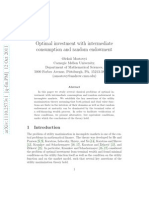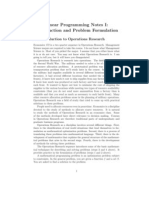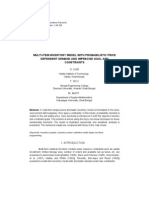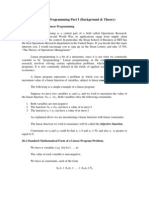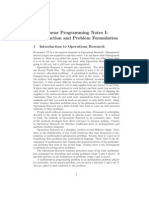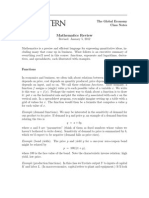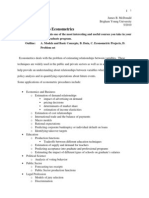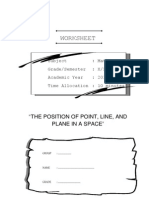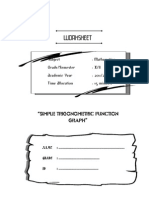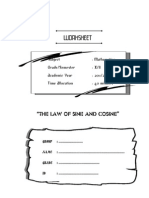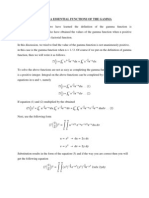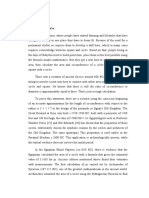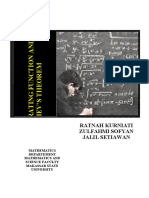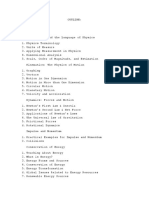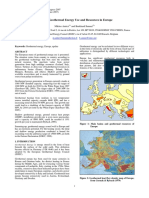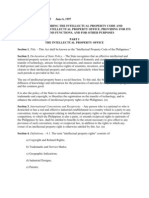A. Background: Mathematical Modeling in Eonomics
A. Background: Mathematical Modeling in Eonomics
Uploaded by
Azizah NoorCopyright:
Available Formats
A. Background: Mathematical Modeling in Eonomics
A. Background: Mathematical Modeling in Eonomics
Uploaded by
Azizah NoorOriginal Description:
Original Title
Copyright
Available Formats
Share this document
Did you find this document useful?
Is this content inappropriate?
Copyright:
Available Formats
A. Background: Mathematical Modeling in Eonomics
A. Background: Mathematical Modeling in Eonomics
Uploaded by
Azizah NoorCopyright:
Available Formats
MATHEMATICAL MODELING IN EONOMICS
CHAPTER I
INTRODUCTION
A. Background
A model is an analogy. Elements and relations in some target domain are
associated to corresponding elements and relations in a model domain, with the
goal that assertions will hold in the target domain just in case the corresponding
assertions hold in the model domain. The model will be a simpler version of the
target, capturing only some of the features of the target domain. Rarely will the
correspondence between target and model be exact. A good model will aid in
understanding of the target domain, help answer questions about the target, and
enable predictions of properties. Results derived from the model can be compared
to those of the target. A model insufficient in some aspect can be refined, new
results derived, and the new model compared to the target.
Science uses many sorts of models. Some are simply stories, literal
analogies. A physical scale model can be used for tests impractical in full scale.
Quantitative models may make precise numerical predictions. Statistical models
may be necessary in the presence of random elements or noise. A scientific theory
is a collection of models conforming to observation and making useful
predictions, often subject to experimental verification. Simpler models are easier
to understand, often easier to derive results for, and seem to provide more likely
explanations of significant phenomena.
Mathematics of various sorts is often used in scientific models. Most often
the mathematics is simply the most convenient and precise language for
expressing the model. Many relations in nature seem to correspond well to
otherwise abstract mathematical constructions. But mathematical modeling
imposes a certain discipline to the modeling process. Mathematics requires precise
definitions. A mathematical model requires that the elements of the target domain
to be modeled are clearly specified. Mathematics makes explicit assumptions. A
GROUP TASK Page 1
MATHEMATICAL MODELING IN EONOMICS
mathematical model will state clearly what conditions must be satisfied for the
model to apply. Mathematics derives necessary conclusions from given
assumptions. The conclusions of a mathematical model are thus necessary facts
about the target domain by the logic of the specifications of elements and the
conditions satisfied by those elements in the target domain. To the extent that
conclusions fail in the target domain, some assumption is violated; some aspect of
the problem is not taken into account in formulating the model.
In economics it can be hard to determine the relevant aspects of a problem,
there are often random unobserved effects, there may be no way to get good
estimates of parameters, and it is usually impossible to do reasonable experiments.
Models that take into account different basic aspects of a problem can be
compared to actual results to at least determine which aspects are the most
relevant. A mathematical model may not be so useful in making precise numerical
predictions as it is for exploring the logical foundations underlying our
understanding of economic questions. In the extreme, this kind of modeling might
be characterized as theoretical economics, but there are also practical problems for
which a disciplined mathematical approach can provide a deeper understanding of
how answers depend on the conditions, what needs to be estimated, and what can
be predicted.
It is in this spirit we undertake to explore a variety of economic questions,
formulating mathematical models to explore underlying assumptions in
economics, aid understanding of basic economic relationships, and explain simple
economic consequences. The lessons here are general; the mathematical modeling
methods demonstrated can be applied in other areas because the conclusions are
logical, dependent on the specification of elements and stated assumptions but not
otherwise dependent on the subject area.
We will not dwell further on an abstract, idealized formulation of
mathematical modeling. It is not our goal to present a system of rules for
mathematical modeling. Modeling is as much art as method. The best way of
GROUP TASK Page 2
MATHEMATICAL MODELING IN EONOMICS
learning about modeling is through example and doing. To illustrate how this will
work we begin with a sample problem and some follow on the explanation of this
paper.
B. Problem Statement
Base to the background before, can be made some problem statement like:
How to take economics in mathematical modeling form:
- In supply and demand function.
- In equilibrium point (linear equation)
- In revenue function
- In cost function
- In single interest
- In series
C. Objective of Paper
Base to the problem statement before, can be made the objective of paper like:
To take economics in mathematical modeling form. Especially:
- In supply and demand function.
- In equilibrium point (linear equation)
- In revenue function
- In cost function
- In single interest
- In series
D. Significant of Paper
In reality, that many people assume that mathematics is a scary subject and
hard to understand, so over this paper writer try to explain that mathematics
can be become in modeling which say mathematical modeling that help
student to understand about mathematics especially in economics.
GROUP TASK Page 3
MATHEMATICAL MODELING IN EONOMICS
CHAPTER II
MATHEMATICAL MODELING IN ECONOMICS
A. Demand and Supply Function
1. Demand Function
The Demand function is a relation between the number of demanded
goods and the goods price, while the supply function is a relation between the
number of goods that is supplied and its price.
The Equation:
(Qd = F.(Px, Py, Ine,T,S, Pop,F)
1. Goods Price (Px)
2. Goods Other Price ( Py)
3. Consumer Income (Inc)
4. Palate (T)
5. Climate (S)
6. The Number of Population (Pop)
7. Forthcoming Prediction (F)
Function:
Figure 1
The notation of demand function of good x is:
Qx = f (Px)
GROUP TASK Page 4
MATHEMATICAL MODELING IN EONOMICS
Qx = a – b Px
Or
Px =a/b – 1/b Qx
Where
Qx : The number of demanded product x
Px: The price of product x
a and b are parameters
The law of demand:
“If the price is increase, then the demand will be decrease. On the
contrary, if the price is decrease, then the demand will be increase.”
Of course, this case is valid on the certain condition.
Thus, if the relation is above the linear, the law of demand will be
described by straight line with negative gradient.
Usually, the symbol for the number of goods is x on the X-axis, while the
symbol for the price is y on the y-ordinate.
Automatically, the negative area is omitted because the negative value of
x,y is meaningless.
If the price is increased from y = 100, we will obtained that x decrease
1
from 12 (see the point Q).
2
The point A (25,0) is convenient with the demand saturation. It means that
although without payment, the number of demand is less than 25, and for this case
the goods called free goods. On the other hand, the point B (0,200) describes that
GROUP TASK Page 5
MATHEMATICAL MODELING IN EONOMICS
if the goods priced 200 or much more, nobody will buy it. Thus, 200 is the highest
price for the customer.
The above figure is the model of common linear demand function.
Besides, we often meet unusual event like following:
The form of demand function is y = constant
(the gradient is zero), means the price is static.
For example, this case is valid for daily needs,
cement, newspaper, water, etc.
Figure 2
The other special event is x = constant, means that
the demand is static, independent from the price.
For example, the minimal needs for going to
barber, or to buy the unique ancient goods.
Figure 3
Example 1:
GROUP TASK Page 6
MATHEMATICAL MODELING IN EONOMICS
1
y=200−8 x∨x=25− y
8
The demand function above describe that for 100 as the price (y=100), we
1 1
obtained the demand 12 or x=12 those are convenient with the point T (
2 2
1
(12 ,100).
2
Figure 4
2. Supply Function
As the balance of the demand function, we also know supply function. The
supply function is the relation between the number of supply or the supplied
goods and the price of the goods.
Figure 5
The Equation:
Qs = F (Px, Py, Fp, T1 ............... )
1. Price
2. Goods other Price
3. Factor Production Cost
4. Technology
5. Company Purpose
GROUP TASK Page 7
MATHEMATICAL MODELING IN EONOMICS
6. Expectation
Function:
The notation of supplied function of good x is:
Qx = f (Px)
Qx = -a + b Px
Or
Px =a/b + 1/b Qx
Where
Qx : The number of supplied product x
Px: The price of product x
a and b are parameters
The law of supply:
“If the price is increase, then the supply will be increase. On the
contrary, if the price is decrease, then the supply will also be decrease”.
Thus, commonly, the form of linear supply function will become a straight
line with positive gradient, although there are some deviations.
Example 2:
The supply demand in the above graph,
describe:
GROUP TASK Page 8
MATHEMATICAL MODELING IN EONOMICS
1
y= x +8∨x=2 y−16
2
The supply is represented by X. For example, for y is equal to 20, then the seller
demand 24 goods. If the price is increase, the supply will become larger and
larger. Especially y=8 is the lowest bound. It means that if the price is less than or
equals to 8 then the seller won’t provide goods again.
Figure 6
B. Equilibrium Point
Equilibrium point is the intersection point of supply and demand function
graphs. It means that on the convenient price with the equilibrium point, the
number of supply is equals to the number of demand (X S = XD). Thus, the
agreement of transaction is reached.
Shown in equation below:
Qd = Qs
Or
Pd = Ps
Is a equilibrium point between demand curve and supply curve.
The process of equilibrium for a kind of goods like above case is based on
the assumption that the price of the goods is not influenced by the other goods, it
doesn’t influence the other goods. Thus, the market situation follows the free
competition pattern.
Example 3:
The demand function
y=60−x … … … … … … … … . ( D )
GROUP TASK Page 9
MATHEMATICAL MODELING IN EONOMICS
and the supply function y=3 x−100 … … … … …..(S)
Intersect at point T (40,20)
Figure 7
Point E is the equilibrium market point.
Figure 8
If there is a seller decrease the price, or the government decides the price is
18 (lower than equilibrium price) then there will be a difference between the
demand and supply, because for the value of y =18 is obtained X D =42 (see the
1
point K) while XS = 39 (see the point L). In means that there are some demand
3
2
(=2 ) can’t be fulfilled (for example, the seller usually save the goods), and the
3
corollary, the customer wants to pay much than 18, just to bu the goods, thus the
price will be increase (although it is not the official price) and will be back to the
equilibrium point. It is also happen when a customer wants to pay more than 20,
the equilibrium is disturbed for a while, but it will be decrease again to the
original equilibrium price.
Market Balance Of Two Kinds Of Products
In the market, demand for certain goods are sometimes influenced by the
demand for goods. This could be occur in two or more kinds of products that
relate substitution (replacement product) or complementary (complementary
GROUP TASK Page 10
MATHEMATICAL MODELING IN EONOMICS
products). Substitution product for example: rice with wheat, kerosene with LPG
gas, and others. While the product complementary example: tea with sugar,
cement with sand, and so forth. This discussion is limited just for interaction of
two kinds of products only.
Mathematically the demand function and supply function of products that
interact have two independent variables. The two independent variables that affect
the quantity of demanded and quantity of supplied are (1) the price of the product
itself, and (2) the price of other products that are interconnected. Notation demand
function becomes:
Q dx =a 0−a1 Px +a 2 P y
Qdy =b 0−b1 Px +b 2 P y
Whereas the Supply Function is:
Q sx =−m0 +m1 P x +m 2 P y
Qsy =−n0 +n1 P x +n2 P y
Where,
Qdx = The amount demanded of product X
Qdy = The amount demanded of product Y
Qsx = Amount on offer from the product X
Qsy = number of products offered Y
Px = price of product X
Py = price of product Y
a0, b0, m0, and n0 is a constant.
Terms of the market balance is achieved when:
GROUP TASK Page 11
MATHEMATICAL MODELING IN EONOMICS
Qsx = Qdx and Qsy = Qdy
Example 4:
Demand function and supply function of the two kinds of products that have
substitution relation as follows:
Q dx =5−2 P x + P y
Qdy =6+ P x −P y
And
Q sx =−5+ 4 P x −P y
Qsx =−4−Px +3 P y
Find its price and market balance!
Solution:
Market balance’s condition:
Qsx = Qdx
−5+ 4 Px −P y =5−2 P x + P y
4 Px +2 P x −P y −P y =5+5
6 P x −2 P y =10 ………….(1)
Qsy = Qdy
−4−P x +3 P y =6+ P x −P y
−P x −Px +3 P y + P y =6+ 4
−2 Px +4 P y =10 ………….(2)
From (1) and (2), we obtain:
GROUP TASK Page 12
MATHEMATICAL MODELING IN EONOMICS
6 P x −2 P y =10 … (× 2 ) 12 P x −4 P y =20
−2 Px +4 P y =10 … ( ×1 )−2 P x + 4 P y =10
+
10 Px +0=30
P x =3
P x =3 6 ( 3 )−2 P y =10
−2 P y =10−18
P y =4
For P x =3 and P y =4 ,
Qx = 5 – 2(3) + 4 and Qy = 6 + 3 - 4
Qx = 3 Qy = 5
So, P x =3 ; P y =4 ; Qx = 3 and Qy = 5.
C. Revenue Function
Revenue are the total proceeds from the sale of products, that is the selling
price per unit (P) multiplied by the quantity sold (Q), or with mathematical
approach as
R=P × Q
If it is depicted in the Cartesians diagram, then line form of total revenue
(TR) is a straight line to the right upper (slope / gradient is positive).
GROUP TASK Page 13
MATHEMATICAL MODELING IN EONOMICS
Figure 9
D. Cost Function
Total cost (TC) can be assumed consist of fixed cost (FC=fixed
cost=overhead cost) and variable cost (VC). Fixed costs (FC) are cost which the
total cost is constant within the range of volume certain activities. In other words
the amount of costs is constant even though the volume of activity (Production)
changes. Examples of fixed costs include: costs to pay for specialist of chemists
food, cost of rental outlets, and the cost of depreciation of production equipment.
If it is depicted in the Cartesian diagram where the vertical axis is the total costs
(Rp) and horizontal axis is the volume of production (Q) then the fixed costs (FC)
are straight lines horizontal.
Figure 10
From the picture above shows that if companies do not produce, the
companies will still bear cost of A rupiah.
Variable costs are costs which the change of total cost is proportional to
the total changes in the volume of activity. More and more goods are produced,
the variable cost will be increases with increasing amount of production.
Examples of variable costs are: raw material costs, the cost of packaging materials
(packaging) and labels. If it is described in Cartesians diagram the line form of
variable costs (VC) is a straight line to the right upper (Slope / gradient is
positive).
GROUP TASK Page 14
MATHEMATICAL MODELING IN EONOMICS
Figure 11
From the picture above shows that if companies do not produce, then no
variable cost.
So, the total cost is the result of the sum of fixed costs with variable costs,
or with a mathematical equation as:
TC=FC +Total VC ,∨¿
TC=FC +VC ∙ Q
If it is described in the Cartesians diagram then line of total cost (TC) is a
combination of the fixed costs (FC) with the total variable costs (TVC) that is a
straight line to top right (positive slope) with initial point is not at the point (0,0)
but starting from fixed costs.
Figure 12
Then, the average cost (AC) is total cost divided by number of
commodities that is sold (x)
So, A=TC/x ( If there is no doubt, TC will be written just C).
GROUP TASK Page 15
MATHEMATICAL MODELING IN EONOMICS
Break Even Point Analysis (BEP Analysis)
Break even, or principal home is a state of companies which the income is
equal to the total costs, in other words the company does not makes a profit but
also do not suffer losses or income equal to zero. For determine break-even point
can be done using two approaches, that is graphs and mathematical approaches.
Graph approach is obtained by finding the intersection between total revenue
graph (TR) with a graph of total costs (TC) as follows:
Figure 13
Mathematical Approach
Calculation of breakeven analysis based on the mathematical equation, as
follows:
Revenue = Total Cost
TR = TC
TR = FC + Total VC
PxQ = FC + (VC x Q)
Where,
TR = Total Revenue
TC = Total Cost
FC = Fixed Cost
VC = Variable Cost per unit
GROUP TASK Page 16
MATHEMATICAL MODELING IN EONOMICS
Q = Quantity
P = Price per unit
E. Single Interest
Let someone owe money to Bank Rp. 1.500.000,00 and have to
prearranged that arrange of one year he should pay back Rp. 1.620.000,00. The
money is Rp. 1.500.000,00 consider as modal and abundance money is Rp.
120.00,00 consider as interest from the debt. The amount of interest often state is
% (read percent) and called as interest unit that is state the comparison between
interest with modal in a time (1 month or 1 year). From the above problem the
interest unit per year can be stated by:
120000
x 100 %=8 %
1500000
In general form, if a modal is M0 interested to get …. Modal is B then the
amount of interest unit can be determined by using a formula below:
B
b= ×100 %
Mo
The end modal can be written:
b
M 1=M 0 + M
100 0
0r
b
(
M 1=M 0 1+
100 )
M1 = the amount of money with return after one periodic
M0 = the amount of modal with owed
b% = interest unit per time unit
If M0 modal interested during n periodic (month or year) and interest unit b
% (per month or per year) by single interest, then formula to determine the
amount of modal include its interest is:
GROUP TASK Page 17
MATHEMATICAL MODELING IN EONOMICS
For first periodic:
M 1=M 0 +B=M 0 +b M 0
M 1=M 0 (1+2 b)
For second periodic:
M 2=M 1+ B=M 0 ( 1+b )+ b M 0
M 2=M 0 (1+2 b)
For third periodic:
M 3=M 2 +B=( 1+2 b ) +b M 0
M 3=M 0 (1+3 b)
And so on for nth periodic is:
M n=M 0 (1+nb)
Or
nb
(
M n=M 0 1+
100 )
Next the formula before can be means that:
M 1=M 0 (1+1 b )
M 2=M 0 (1+2 b )
M 3=M 0 (1+3 b)
Etc
Next can be explained that:
M 3−M 2=M 2−M 1=M 1−M 0=B=b . M 0
In general form can be written:
M n−M n−1=B=b . M 0
Note: the formula to determine the end modal with interest unit system is
arithmetic series form:
GROUP TASK Page 18
MATHEMATICAL MODELING IN EONOMICS
M 0 = the first modal (first unit)
B = b M 0 = different
M n = modal after nth periodic
So, the formula M n=M 0 (1+nb) equals:
U n =a+ ( n−1 ) b
Where:
a = first unit
b = different (d)
Un = nth unit
F. Sequence / Series
1. Sequence / Arithmetic Series
Arithmatic series is a series that the changing of it term based on the sum of
certain number. The numbers that difference the other numbers called
different.
* the n-th terms
Un = a + ( n – 1 ) B
Where ;
Un = the n-th terms
a = first term ( S1 )
B = different
GROUP TASK Page 19
MATHEMATICAL MODELING IN EONOMICS
n = Index
* The sum of term
Is the sum of series until certain terms.
Sn = n/2 ( 2a + ( n – 1 ) B )
Sn = The total of the n-th term
Example 5
A factory this year began producing 800 cars each year and each subsequent year
of production capacity increased by 50 units. How much production 6 years later
(in the year to 7th)? How to sum of all production at the time?
Answer :
The above problem back to the line count with a = s1 = 800, different from b=
50. Production in year 7th is s7 = 800 + 6 (50) = 2100. The total production is the
sum of 7 arithmetic series terms which corresponding
n 7
d7 = ( s 1+s 7 )= ( 800+ 2100 )=10150.
2 2
2.Sequence / Measure Series
Is a series that the changing of it’s terms based on the multiplication of
certain number. The number that different the other numbers called different..
* The nth terms
Un = a . r n-1 Where ; a = first term
r = ratio
* Total of n terms
Is a total of the value of each terms from the first term until the n-th term.
Sn = a ( 1 – rn ) Sn = a ( 1 – rn )
GROUP TASK Page 20
MATHEMATICAL MODELING IN EONOMICS
1–r r–1
For r < 1 For r > 1
Much a matter of interest income based on the construction of a
compound, such as a matter of annuities, discounts and so forth.
Example 6
The monetary capital of 40 million which interested income compounded with
interest rate of 10% per year and 1-month interest income period will follow the
low of measure sequence with a = s1 = 40 (in millions) and the comparison p = (1
+10 / 12%) = 121/120 then within 2 years for example, the monetary capital will
be s25 = ap24 = 48.82 million.
CHAPTER III
CLOSING
A. Conclusion
1. Demand and Supply Function
Demand Function:
The Demand function is a relation between the number of demanded goods
and the goods price, while the supply function is a relation between the
number of goods that is supplied and its price.
(Qd = F.(Px, Py, Ine,T,S, Pop,F)
Qx = a – b Px or Px =a/b – 1/b Qx
Supply Function:
The supply function is the relation between the number of supply or the
supplied goods and the price of the goods.
Qs = F (Px, Py, Fp, T1 ............... )
Qx = f (Px)
GROUP TASK Page 21
MATHEMATICAL MODELING IN EONOMICS
Qx = -a + b Px Or Px =a/b + 1/b Qx
2. Equilibrium Point
Equilibrium point is the intersection point of supply and demand function
graphs. It means that on the convenient price with the equilibrium point, the
number of supply is equals to the number of demand. Show in equation
below:
Qd = Qs
Or
Pd = Ps
3. Revenue Function
Revenue are the total proceeds from the sale of products, that is the selling
price per unit (P) multiplied by the quantity sold (Q), or with mathematical
approach as
R=P × Q
4. Cost Function
Total cost (TC) can be assumed consist of fixed cost (FC=fixed
cost=overhead cost) and variable cost (VC). Fixed costs (FC) are cost which
the total cost is constant within the range of volume certain activities.
Variable costs are costs which the change of total cost is proportional to the
total changes in the volume of activity. And the volume of production (Q).
Its equation is:
TC=FC +Total VC ∨TC=FC +VC ∙ Q
5. Single Interest
nb
M n=M 0 (1+nb) Or (
M n=M 0 1+
100 )
GROUP TASK Page 22
MATHEMATICAL MODELING IN EONOMICS
6. Sequence / Series
• Sequence / Arithmetic Series
Sn = n/2 (2a+(n-1)b)
Un= a + (n-1)b
• Sequence / Measure Series
For p<1, Sn=
For p>1, Sn=
B. Suggestion
To make this paper we (writer) have arduousness to collect the literatures
about this material because in library there are just few books about that. And we
also have limitation to find literature in another place or out of library campus or
we just can see in our economics book in senior high school. So that, we suggest
to library administration to more maximize their collection books especially in
subject mathematical modeling.
Actually in the making of this paper, we still have confusing about the
materials because there are many equation and graph we don’t know how to get it.
So for the lecture and our senior, please explain more about this material.
GROUP TASK Page 23
MATHEMATICAL MODELING IN EONOMICS
REFERENCES
B, Susanta, Bambang Soedijono. 1993. Materi Pokok Model Matematik. Jakarta:
Karunika Universitas Terbuka.
http://www.search-pdf.com/matematika%20Keuangan%20-%20Final_bab%201
http://pdf.com/matematika/ekonomi/te_mik_2%20bab_1
http://pdf.com/matematika/penerapan%20fungsi%20linear
GROUP TASK Page 24
MATHEMATICAL MODELING IN EONOMICS
APPENDICES
GROUP TASK Page 25
You might also like
- The Hundred-Page Machine Learning Book - Andriy BurkovDocument16 pagesThe Hundred-Page Machine Learning Book - Andriy BurkovKlepsusNo ratings yet
- Old School Hex Crawling HacksDocument50 pagesOld School Hex Crawling HacksNever disco75% (4)
- Intermediate Microeconomics AnswerDocument11 pagesIntermediate Microeconomics AnswerWinnie Wong50% (2)
- Journal of Management Education 2001 Comer 430 6Document8 pagesJournal of Management Education 2001 Comer 430 6senadi14No ratings yet
- College Teaching and ExcelDocument14 pagesCollege Teaching and Excelarif0204No ratings yet
- Ecu - 07103 Lecture Notes PDFDocument63 pagesEcu - 07103 Lecture Notes PDFKhalid Mahadhy0% (1)
- 01 Introduction1Document10 pages01 Introduction1Ethio PNo ratings yet
- Mathemathical Economics CH - 1Document31 pagesMathemathical Economics CH - 1kasahun tilahunNo ratings yet
- Machine LearningDocument15 pagesMachine LearningKommi Venkat sakethNo ratings yet
- General Mathematics First Semester 1 Quarter 2021 - 2022 1 1 Chapter 1: Introducing FunctionsDocument27 pagesGeneral Mathematics First Semester 1 Quarter 2021 - 2022 1 1 Chapter 1: Introducing FunctionsJesZ AiAhNo ratings yet
- Business Math F502 34036 Mohammad Faisal KarimDocument9 pagesBusiness Math F502 34036 Mohammad Faisal KarimFaisal KarimNo ratings yet
- Applying Deep Learning To The Newsvendor ProblemDocument20 pagesApplying Deep Learning To The Newsvendor Problemharris.af13No ratings yet
- Operations Research Bac 350Document44 pagesOperations Research Bac 350kalulutiza0No ratings yet
- Mathematics For Economics 2marksDocument4 pagesMathematics For Economics 2marksjacqulineinbarajNo ratings yet
- Wa0016.Document8 pagesWa0016.sanittarosNo ratings yet
- Macro s01Document7 pagesMacro s01winniNo ratings yet
- PART B Report Eko Maths (Assignment 2)Document6 pagesPART B Report Eko Maths (Assignment 2)Nur IrdinaNo ratings yet
- SupplementDocument327 pagesSupplementnazmul islamNo ratings yet
- Modelling As A Support in Teaching of Mathematics: Ivan Meznik, Brno University of Technology, Czech RepublicDocument6 pagesModelling As A Support in Teaching of Mathematics: Ivan Meznik, Brno University of Technology, Czech RepublicNawab JeeraNo ratings yet
- Machine LearningDocument60 pagesMachine Learningjaweria arshadNo ratings yet
- Bab I.docx Sogi AkbarDocument15 pagesBab I.docx Sogi AkbarMau-ZyJr.No ratings yet
- Inverse Problems An Introduction - kirchgraber-Kirsch-Sto ErDocument27 pagesInverse Problems An Introduction - kirchgraber-Kirsch-Sto ErCortney MossNo ratings yet
- Application of Mathematics in Economics: A Study With Different PerspectivesDocument5 pagesApplication of Mathematics in Economics: A Study With Different PerspectivesKwok Kwan YongNo ratings yet
- MB0032 Set-1Document9 pagesMB0032 Set-1Shakeel ShahNo ratings yet
- 2.7 Applications of Derivatives To Business and EconomicsDocument6 pages2.7 Applications of Derivatives To Business and EconomicssupermannonNo ratings yet
- Algebra 2 CriticalDocument10 pagesAlgebra 2 Criticalapi-115680157No ratings yet
- Machine Learning NotesDocument15 pagesMachine Learning NotesxyzabsNo ratings yet
- Solving Continuous Set Covering Problems by Means of Semi Infinit OptimizationDocument44 pagesSolving Continuous Set Covering Problems by Means of Semi Infinit OptimizationRiri LestariNo ratings yet
- Hilpisch 2020 Artificial Intelligence in Finance 1 477 PagesDocument7 pagesHilpisch 2020 Artificial Intelligence in Finance 1 477 Pagesthuyph671No ratings yet
- 2003 03 01 MathModelingDocument29 pages2003 03 01 MathModeling'Nabeela MahmoodNo ratings yet
- Optimal Investment With Intermediate Consumption and Random EndowmentDocument20 pagesOptimal Investment With Intermediate Consumption and Random Endowmentquew3No ratings yet
- Linear Programming Notes I: Introduction and Problem FormulationDocument11 pagesLinear Programming Notes I: Introduction and Problem FormulationNavdeep Singh DhillonNo ratings yet
- Unit 2Document24 pagesUnit 2Thảo NguyệtNo ratings yet
- Multi-Item Inventory Model With Probabilistic Price Dependent Demand and Imprecise Goal and ConstraintsDocument12 pagesMulti-Item Inventory Model With Probabilistic Price Dependent Demand and Imprecise Goal and ConstraintsManan MehraNo ratings yet
- Linear ProgmDocument9 pagesLinear Progmapi-3703344No ratings yet
- ML: Introduction 1. What Is Machine Learning?Document38 pagesML: Introduction 1. What Is Machine Learning?rohitNo ratings yet
- SSRN Id3950568Document52 pagesSSRN Id3950568leonNo ratings yet
- W6 Lesson 5 - Introduction To Optimization and Linear Programming - ModuleDocument21 pagesW6 Lesson 5 - Introduction To Optimization and Linear Programming - ModuleElmeerajh JudavarNo ratings yet
- Describe The Structure of Mathematical Model in Your Own WordsDocument10 pagesDescribe The Structure of Mathematical Model in Your Own Wordskaranpuri6No ratings yet
- Cal Reform 1Document200 pagesCal Reform 1abbas zaidiNo ratings yet
- Mathematics of Management NotesDocument51 pagesMathematics of Management Notesraja kashyapNo ratings yet
- Econometrics - SlidesDocument264 pagesEconometrics - SlidesSamuel ObengNo ratings yet
- Linear Programming NotesDocument92 pagesLinear Programming Notesmiss_bnm0% (1)
- Mathematics Review: The Global Economy Class NotesDocument10 pagesMathematics Review: The Global Economy Class NotesAshish MehtaNo ratings yet
- 71download Full Solution Manual For Intermediate Microeconomics and Its Application 11th Edition by Nicholson All ChaptersDocument37 pages71download Full Solution Manual For Intermediate Microeconomics and Its Application 11th Edition by Nicholson All Chaptersreinzmihna100% (1)
- Bifurcations Economics Models PDFDocument24 pagesBifurcations Economics Models PDFComplejidady EconomíaNo ratings yet
- Function 2Document91 pagesFunction 2tigarir260No ratings yet
- Chapter 3 in Managerial EconomicDocument46 pagesChapter 3 in Managerial EconomicmyraNo ratings yet
- Nature of Mathematical Economics: Contact Information: Kadjei-Mantey@ug - Edu.ghDocument19 pagesNature of Mathematical Economics: Contact Information: Kadjei-Mantey@ug - Edu.ghDarling Jonathan WallaceNo ratings yet
- Linear RegressionDocument15 pagesLinear RegressionSamriddhi JaiswalNo ratings yet
- All chapter download Intermediate Microeconomics and Its Application 11th Edition Nicholson Solutions ManualDocument42 pagesAll chapter download Intermediate Microeconomics and Its Application 11th Edition Nicholson Solutions Manualtheteeareez100% (1)
- What Is Machine LearningDocument15 pagesWhat Is Machine Learningch MuzammalNo ratings yet
- Unit Mathematical Modelling - An Overview: StructureDocument16 pagesUnit Mathematical Modelling - An Overview: StructurePramod DhaigudeNo ratings yet
- Notes On EconometricsDocument295 pagesNotes On EconometricsTabarnoucheNo ratings yet
- Introduction. Binary Classification and Bayes Optimal ClassifierDocument7 pagesIntroduction. Binary Classification and Bayes Optimal ClassifierYiwei ChenNo ratings yet
- Estimating Econometric Models With Fixed EffectsDocument14 pagesEstimating Econometric Models With Fixed Effectspedda60No ratings yet
- 1-s2.0-S089812210100325X-mainDocument8 pages1-s2.0-S089812210100325X-mainCESAR AUGUSTO PINEDA PEREZNo ratings yet
- Monte Carlo Simulation HandoutsDocument8 pagesMonte Carlo Simulation HandoutskatecutiewangNo ratings yet
- PDF 3Document3 pagesPDF 3Quỳnh Anh ShineNo ratings yet
- Noor Azizah - Exponential Moving Average1Document7 pagesNoor Azizah - Exponential Moving Average1Azizah NoorNo ratings yet
- Exponential Moving AverageDocument12 pagesExponential Moving AverageAzizah NoorNo ratings yet
- Worksheet: "The Position of Point, Line, and Plane in A Space "Document4 pagesWorksheet: "The Position of Point, Line, and Plane in A Space "Azizah NoorNo ratings yet
- WORKSHEET - Draw Trigonometric Function GraphDocument7 pagesWORKSHEET - Draw Trigonometric Function GraphAzizah NoorNo ratings yet
- WORKSHEET - Sine and Cosine LawDocument6 pagesWORKSHEET - Sine and Cosine LawAzizah NoorNo ratings yet
- Semester ProgramDocument3 pagesSemester ProgramAzizah NoorNo ratings yet
- Lesson Plan PbiDocument7 pagesLesson Plan PbiAzizah NoorNo ratings yet
- Student Book TrigonometryDocument20 pagesStudent Book TrigonometryAzizah NoorNo ratings yet
- Pembuktian Gamma (1/2) Akar - PiDocument3 pagesPembuktian Gamma (1/2) Akar - PiAzizah Noor80% (5)
- History of PiDocument14 pagesHistory of PiAzizah Noor100% (1)
- Realistic Mathematics EducationDocument37 pagesRealistic Mathematics EducationAzizah Noor50% (2)
- Fungsi Pembangkit Moment & Teorema ChebisevDocument13 pagesFungsi Pembangkit Moment & Teorema ChebisevAzizah NoorNo ratings yet
- ETIKA Komputer SDN BHDDocument2 pagesETIKA Komputer SDN BHDwiliam hongNo ratings yet
- Jtagjet-C2000: Emulator For The C2000 Family of Mcu/Dsps From Texas InstrumentsDocument3 pagesJtagjet-C2000: Emulator For The C2000 Family of Mcu/Dsps From Texas Instrumentsreza yousefiNo ratings yet
- SingalongSong BookDocument27 pagesSingalongSong BookStephanie StottNo ratings yet
- The Impact of Entertainment On PDFDocument21 pagesThe Impact of Entertainment On PDFTanishkaNo ratings yet
- Rights of Child Born Out of A Live-In RelationshipDocument10 pagesRights of Child Born Out of A Live-In RelationshipAdvocateNo ratings yet
- Latihan Soal Olimpiade Bahasa Inggris Tanpa Kunci JawabanDocument11 pagesLatihan Soal Olimpiade Bahasa Inggris Tanpa Kunci JawabanRatna Aristiya Dewi AnggraeniNo ratings yet
- Direct-Link USB100PFBDocument2 pagesDirect-Link USB100PFBOmar Alfredo Del Castillo QuispeNo ratings yet
- Tax Justice and Advocacy Clinic 2Document241 pagesTax Justice and Advocacy Clinic 2Handley Mafwenga Simba100% (1)
- STPM 2004 p2 AnswerDocument20 pagesSTPM 2004 p2 AnswersuhailieliasNo ratings yet
- Modeling and Simulation of Photovoltaic Water Pumping SystemDocument6 pagesModeling and Simulation of Photovoltaic Water Pumping SystemAnonymous GmUbEhBknUNo ratings yet
- Learning OpenStack Networking (Neutron) - Second Edition - Sample ChapterDocument28 pagesLearning OpenStack Networking (Neutron) - Second Edition - Sample ChapterPackt PublishingNo ratings yet
- Strategic Planning HRDocument31 pagesStrategic Planning HRAbdur RehmanNo ratings yet
- VLSI Guide: Floor Planning and Power Planning Interview QuestionsDocument24 pagesVLSI Guide: Floor Planning and Power Planning Interview QuestionssrajeceNo ratings yet
- History MedtechDocument4 pagesHistory MedtechBrent LagartoNo ratings yet
- Electricity GenerationDocument6 pagesElectricity GenerationDiego TimoteoNo ratings yet
- PDF Super Resolution Imaging 1st Edition Peyman Milanfar downloadDocument71 pagesPDF Super Resolution Imaging 1st Edition Peyman Milanfar downloadronjutsona42100% (12)
- Capacity Utilisation and OutsourcingDocument3 pagesCapacity Utilisation and OutsourcingJared OtienoNo ratings yet
- The Health Benefits of TeaDocument7 pagesThe Health Benefits of Teaapi-281746606No ratings yet
- Department of Mathematics, IIT Madras MA2031-Linear Algebra For Engineers Assignment-IIDocument2 pagesDepartment of Mathematics, IIT Madras MA2031-Linear Algebra For Engineers Assignment-IIhellokittyNo ratings yet
- LMH6525/LMH6526 Four-Channel Laser Diode Driver With Dual OutputDocument15 pagesLMH6525/LMH6526 Four-Channel Laser Diode Driver With Dual OutputFalsedad Mas FalsoNo ratings yet
- OUTLINE of SCIENCE TopicsDocument7 pagesOUTLINE of SCIENCE TopicsLeelee the GreatNo ratings yet
- Doing Business in The Kingdom of Saudi Arabia: A Tax and Legal GuideDocument26 pagesDoing Business in The Kingdom of Saudi Arabia: A Tax and Legal GuideDiwakar Roy100% (1)
- SREDocument8 pagesSREAlexandra ParaschivNo ratings yet
- Effect of Welding Current Voltage On Tensile Strength of Pressure Vessel Steel Submerged Welded JointsDocument4 pagesEffect of Welding Current Voltage On Tensile Strength of Pressure Vessel Steel Submerged Welded JointsCioroaga Bogdan DorelNo ratings yet
- Republic Act No 8293Document29 pagesRepublic Act No 8293Juan Carlo RilleraNo ratings yet
- Money FrogDocument8 pagesMoney FrogLinda LouisNo ratings yet
- Econ Dev AssignDocument2 pagesEcon Dev AssignFav TangonanNo ratings yet
- MODULE 3-ICE CyclesDocument4 pagesMODULE 3-ICE CyclesNigel Ceasar SilvaNo ratings yet


